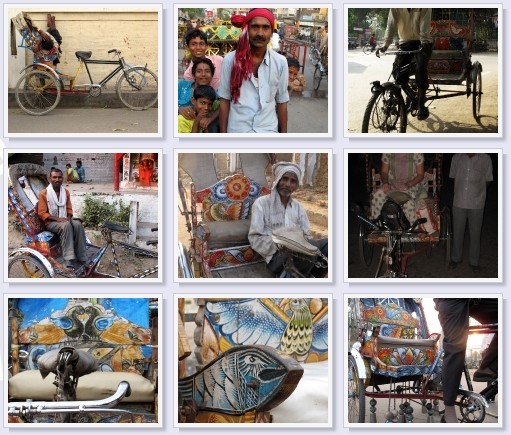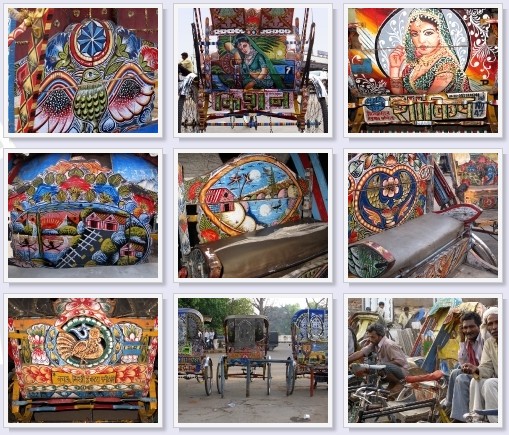Rickshaw Art in a City Settled by God
April 2011

Allahabad is a city at the meeting point of India’s two holiest rivers, the Yamuna and Ganges, as well as a third, mythical river, called the Saraswati. The waters swirl together at the Sangam, where boatmen row pilgrims out to perform kirtan. According to Swami Sivananda, a guru who spent his life on the Ganges, “even atheists will have faith in God if they do boat kirtan” – but Swami Sivananda didn’t have to deal with Allahabad’s touts and, although the city’s Persian name means ‘Settled by God’, Claire and I – when we passed through, following the Yamuna from Delhi – experienced a city of petty irritations and mercenary auto-rickshaw drivers, who unashamedly tried to charge us four or five times what an Indian would pay, and abused us when we protested.
Allahabad’s cycle-rickshaw wallahs were different. We woke two – asleep on the roadside, a field mouse scrambling over their blankets – when we left the city at 5am, to carry us with our bags to the station. Neither complained or charged any extra. Another cycled us from Moghul tombs to our hotel. He mopped the sweat from his arms and neck while we dug out our money, then refused the ten extra rupees we offered. The men were honest, as rustics often are, but were proud too – proud and perhaps poor enough to consider the extra money we offered a kind of charity, and accepting it a degradation.
I was fascinated by their vehicles. Cycle-rickshaws rattle along streets across Asia, carrying freight as well as people, but Allahabad’s cycle-rickshaws were special: rural landscapes and Bollywood starlets, as well as animals and symbols of luck were hand-painted onto the carriages. The armrests were carved in the shape of fish, and occasionally the whole carriage had been carved – hollowed out to more closely resemble an animal, or sculpted at the edges in decorative waves and columns. Heavy brass bells dangled from the rickshaws’ bottoms and tinsel was stuck in patterns to the canopies. The attention to form made these cycle-rickshaws – industrial objects by definition – seem pre-industrial. Although only a tool, to be used for hard, low-paid work, every rickshaw was unique, hand-crafted and, in its way, beautiful.
The rickshaw wallahs did not own their vehicles; they were rented at a cost – according to a rare English speaker – of twenty rupees per day. But these sunburnt, hard-bitten men slept beside their rickshaws at night and napped in them during the day. They smiled proudly when I asked to photograph them with their vehicles, or wrapped up their turbans and stared into the camera with great seriousness. It was hard to imagine that they would not get attached to a single rickshaw, in time, and derive personal pride from its appearance.
I wanted to seek out the workshops where these rickshaws were made, to meet the artists and businessmen who had claimed the cycle-rickshaw as a folk art canvas. I wanted to know what economics lay behind the impractical decoration of such practical objects, but Claire and I were short on time. We had booked a ticket to Varanasi, 120km away. Our journey along the Yamuna was over and we were now tracing the course of Mother Ganga.



Website Designed by Gautam Chaudhary
Except as noted, this work is licensed under a Creative CommonsAttribution-NonCommercial-NoDerivs 3.0 Unported License.



